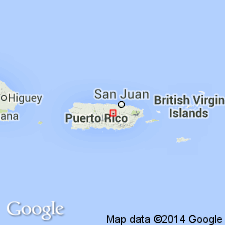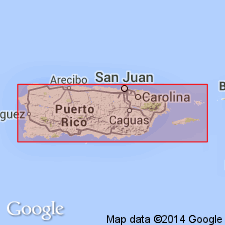
- Usage in publication:
-
- Ortiz Formation*
- Modifications:
-
- Named
- Dominant lithology:
-
- Sandstone
- Shale
- AAPG geologic province:
-
- Caribbean region
Summary:
The Ortiz Formation, here named, consists of calcareous, thick-bedded coarse sandstone with interbeds of dusky-red shale at the base, overlain by thin conglomerate and varicolored volcanic sandstone and siltstone and pale-green tuff. Conformably overlies the Corozal Limestone; upper part is not exposed because of faulting. Maximum thickness is 600 m. Age is Paleocene or Eocene based on age of the Corozal.
Source: GNU records (USGS DDS-6; Reston GNULEX).

- Usage in publication:
-
- Ortiz Formation*
- Modifications:
-
- Overview
- AAPG geologic province:
-
- Caribbean region
Summary:
The Ortiz Formation occurs in eastern Puerto Rico and consists of volcanic sandstone, siltstone, tuff, and a basal conglomerate. Maximum thickness is 600 meters. The Ortiz is of Tertiary(?) age.
Source: GNU records (USGS DDS-6; Reston GNULEX).
For more information, please contact Nancy Stamm, Geologic Names Committee Secretary.
Asterisk (*) indicates published by U.S. Geological Survey authors.
"No current usage" (†) implies that a name has been abandoned or has fallen into disuse. Former usage and, if known, replacement name given in parentheses ( ).
Slash (/) indicates name conflicts with nomenclatural guidelines (CSN, 1933; ACSN, 1961, 1970; NACSN, 1983, 2005, 2021). May be explained within brackets ([ ]).

